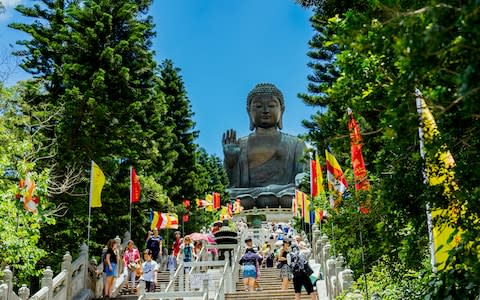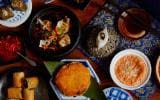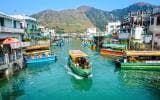18 amazing free things to see and do in Hong Kong

More insider guides for planning a trip to Hong Kong
48 hours 48 hours
Hotels Hotels
Attractions Attractions
Restaurants Restaurants
Free Free
Nightlife Nightlife
For a city that regular ranks as one of the world's most expensive places to live, Hong Kong has a phenomenal amount of free things to see and do, from manic madly-photogenic markets to niche museums (many of which are free on Wednesdays) to serene temples scented with beehive incense. And despite its reputation as a concrete jungle, more than 70 per cent of the territory is dedicated green land, home to hundreds of miles of walking and hiking trails, lovely beaches (complete with barbecue pits, showers and loos), old-fashioned fishing villages and ace urban parks.
Hong Kong Island
Man Mo Temple
Visitors to Hong Kong tend to come here as their single temple excursion, partly because it is convenient to Central and partly because it is so atmospheric inside. The temple has been here since 1847, and is where the Tung Wah Group of Hospitals, which runs it, still hold Autumn Sacrificial Rites every year for Hong Kong’s continuing prosperity. It’s not huge, which means it can be crowded with tour groups in the mornings, and if you are asthmatic you may find the giant incense coils, hanging picturesquely but smokily from the roof, bothersome. It is better to pop in during the quieter afternoons, pausing for a serene, fragrant moment, and watching the ash drop to the stone floor while locals make offerings. The temple is close to Cat Street for souvenir shopping, and plenty of coffee shops and cafés.
Contact: 00 852 2540 0350
Opening times: Daily, 8am-6pm
Getting there: Central MTR station (exit D2), then Central-Mid-Levels escalator to Hollywood Road, then 10-minute walk; or Sheung Wan MTR station (exit A2), then 10-minute uphill walk
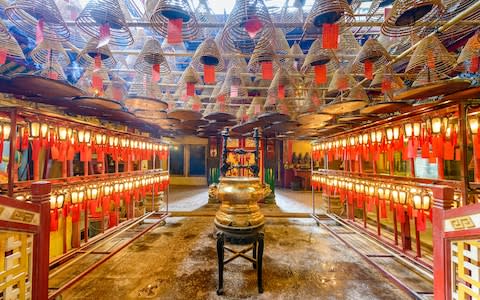
• An insider guide to Hong Kong
Tai Ping Shan
Tai Ping Shan is now one of the most delightful districts on Hong Kong Island to have a stroll. It’s hilly, so you might want to take the Central-Mid-Levels escalator to Caine Road after 10.20am (which is when the escalator changes direction from down to up). Turn right, walk along Caine Road for five minutes, then down the steps of Ladder Street. The Museum of Medical Sciences (closed Mondays, HK$10/£1 admission) is on your left; keep descending, and turn left into Tai Ping Shan Street. These lanes have a sort of quirky, nostalgic flavour; they are full of a mix of coffee shops, young design studios, and old traditions. Don’t miss the little Earth God shrine, on the corner of Water Street, or the Kwun Yam and Pak Sing temples further along where incense coils sweeten the air.
Getting there: Central MTR station (exit D2)

• Amazing things to do in Hong Kong
Lo Pan Temple
Given that Hong Kong is such a thicket of high-rises, it’s surprising that there’s only one temple to Lo Pan, the Chinese god of builders and carpenters. The temple is hidden away in Kennedy Town, at the end of a tree-shaded, car-less street at the top of two steep flights of steps. It was built in 1884 and has an unusual outline and some lovely ceramic figures on the roof: in late afternoon sunlight, they look like a crowd of tiny villagers gossiping about the day’s events. It’s beautifully kept inside. On Lo Pan’s festival – the 13th day of the sixth lunar month, which falls on July 15 in 2019 and August 2 in 2020 – the city’s builders still come to this quiet spot to pay their respects.
Opening times: Daily, 9.30am-5pm
Getting there: Multiple buses or tram to Kennedy Town; or Kennedy Town MTR station

• The best nightlife in Hong Kong
Dragon's Back to Big Wave Bay
If you do just one hike during your Hong Kong visit, it should be this one, which offers stupendous sea views from the rocky dragon’s spine of eastern Hong Kong Island. The hike takes about 2.5 hours, is just strenuous enough to feel you’ve had a pleasant workout and shouldn’t be a problem for fit children. In fact, the most difficult bit is usually spotting where to get off on the number 9 bus route. The bus website has a photo of the To Tei Wan stop, and on weekends you’ll spot other hikers getting off. Do note that this trail has very little shade and is wind-exposed, so definitely bring sunblock and a hat as well as water.
Address:Start at To Tei Wan pavilion, Shek O Road
Getting there: Shau Kei Wan MTR station (exit A3), then bus 9 to To Tei Wan stop
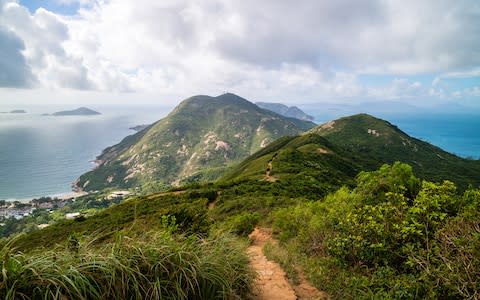
• The best hotels in Hong Kong
Hong Kong Park
This well-thought-out park is one of those little urban miracles that residents tend to take for granted. It’s next to the British consulate and close to the Peak Tram terminus. There’s an excellent aviary and if you really want to delve into local avian detail, you can join the free bird-watching group that meets every Wednesday at 8am by the lake. The Flagstaff House Museum of Teaware – the oldest Western-style building in Hong Kong – is so charming that you’ll have to fight your way through all the brides posing outside for their wedding photos. Admission is free, the exhibits are delightful, and there are frequent lectures and tea ceremonies.
Note: The Edward Youde Aviary of Hong Kong Park will be temporarily closed from September 17, 2018 to February 1, 2019 for refurbishment work.
Contact: 00 852 2521 5041; lcsd.gov.hk
Opening times: Park: daily, 6am-11pm; aviary: daily, 9am-5pm; Museum of Teaware: Mon, Wed-Sun, 10am-6pm
Getting there: Admiralty MTR station (exit C1)

• The best restaurants in Hong Kong
Stanley Market
Everyone goes to Stanley at least once, so be prepared for crowds. In theory, it should be a nightmare but the location, right by the sea, is still lovely and the village has been gently gentrified with a boardwalk, complete with bars and cafés – just enough to make it a pleasant day out. The market, which is right in the middle of the village, is more organised than it used to be. Expect T-shirts, paintings, silk, bags, linen, luggage, hats, and ski wear (really). The quality is rather better than in other street markets, so local residents tend to frequent it too. Don’t confine yourself to the main bazaar. There’s an overspill into the little streets around it, and you’ll tend to find more original takes on the same retail themes there.
Contact:hk-stanley-market.com
Opening times: Daily, 10am-6pm but individual stalls vary
Getting there: Central MTR station (exit A) to Exchange Square bus station, then 6, 6A, 6X, 66, 260; or bus 973 from Tsim Sha Tsui
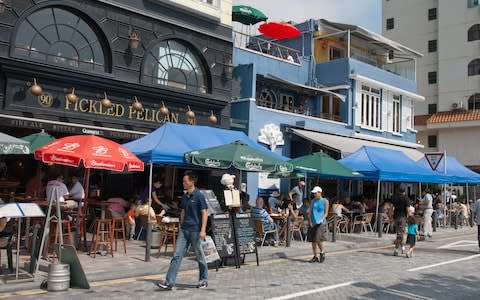
• The best shopping in Hong Kong
Lung Fu Shan Fitness Trail
If the thought of the Peak Tram queue is off-putting, you can always do this 45-minute, signposted hike, scenically bypassing the hordes. Go early in the morning and you’ll see why Hong Kong has one of the longest-lived populations in the world: the lower trail is full of senior citizens bending, flexing, jogging, tending little gardens and fish ponds, and making tea. Further along, you can pass through Pinewood Battery, where Hong Kong tried to defend itself from the Japanese invasion of 1941. It was abandoned afterwards, and although it’s been cleaned up to create a picnic area (complete with loo), there’s still lingering evidence of artillery scars. The last section is almost flat, a pleasant winding path under trees that loops round to the Peak Tower.
Address: Pokfield Road Bus Terminus
Getting there: HKU MTR station (exit C1), short walk to Pokfield Road Bus Terminus, then walk up stone steps behind; or bus (multiple options) to Pokfield Road Bus Terminus
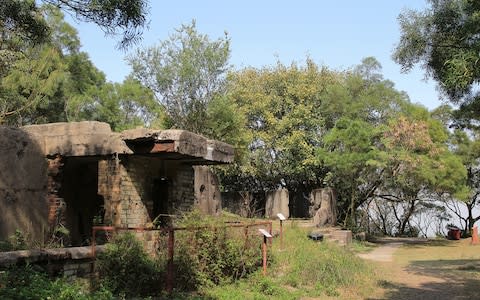
• The best beaches in Hong Kong
Pedder Building Art Galleries
Hong Kong has a brilliant capacity to re-invent itself. In 2007, when it was generally perceived as a cultural desert, it held its first international art fair, and now it hosts Art Basel every spring. There are many galleries dotted around the city but if you want a quick fix, go to the Pedder Building. Take the lift to the seventh floor and start with Gagosian, the New York gallery that brought Damien Hirst (amongst many others) to Hong Kong. Then work your way down through Pearl Lam (Chinese contemporary art), Hanart TZ (ditto), Ben Brown Fine Arts (international contemporary) and Simon Lee (ditto). You won't necessarily love everything you see, but this is where you can take the pulse of what’s become one of the most important art markets in the world.
Getting there: Central MTR station (exit D2)
Opening times: Tue-Sat, 11am-7pm
• The best things to do in Macau
Shek O
Shek O offers a wonderful contrast to the city’s clamour. Sit on the top of the number 9 double-decker bus on the right-hand side, and you’ll get the best view of its approach. As a beach experience, it combines childhood memories of seaside resorts (shops selling buckets and spades, paddling, deckchairs) with a vivid Chinese flavour (temples, sound of mahjong, barbeque pits where everyone gathers at weekends). It’s crowded on summer weekends but on a sunny winter’s day, it’ll be you, the paragliders soaring off the Dragon’s Back (the high ridge which rises at the back of the village) and the occasional bride having her wedding pictures taken in the photogenic surf.
Contact:lcsd.gov.hk
Getting there: Shau Kei Wan MTR station (exit A3), then bus 9 to Shek O stop
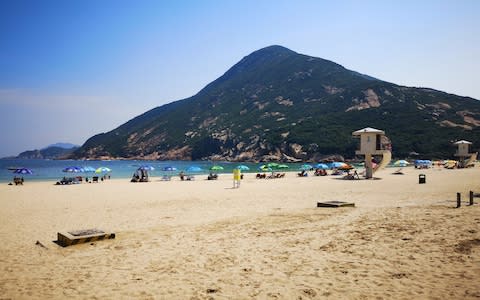
Deep Water Bay
Repulse Bay is a popular beach on Hong Kong’s Southside – it’s the nearest one to Central so you can see all the tour buses lined up behind it – and for that reason, it's better to opt for the adjacent Deep Water Bay. It’s smaller and quieter, with a pleasant sickle of sand and shady trees that mask the sound of passing traffic. This is where early-morning swimmers (the marine equivalent of those dawn tai-chi practitioners in the parks) dip their toes. If you’re suddenly desperate for company and the wider expanses of Repulse Bay, there’s a boardwalk connecting both beaches, which is an enjoyable – and, in Hong Kong, fairly rare – way to get some simple outdoor exercise, especially with young children.
Contact:lcsd.gov.hk
Getting there: Central MTR station (exit A), then walk to Exchange Square bus terminus, then bus 6, 6X, 260
• The best restaurants in Macau
Kowloon
Chi Lin Nunnery
That fact that Chi Lin Nunnery can be found amidst the unremarkable high-rises of Diamond Hill adds to the sense of a spiritual jewel. It was built in 1934 according to feng shui principles and, famously, no nails were used in its construction – an architectural metaphor within the city’s metallic, clanging onslaught. There’s a sweet, sparse simplicity here which it’s worth taking time to absorb. You can wander through the halls and by lotus ponds, then enjoy the adjacent Tang-dynasty-style Nan Lian Garden, and eat at the Chi Lin Vegetarian Restaurant. Hong Kong has many crowded places – this is certainly not one of them.
Contact: 00 852 2354 1888; chilin.org
Opening times: Daily, 9am-4.30pm
Getting there: Diamond Hill MTR station (exit C2)

Kowloon Walled City Park
Before it was demolished, Hong Kong’s Kowloon Walled City was once filled with infamous, triad-infested alleyways and fishball factories. Its past may have been decidedly lurid but this park is a lovely legacy. The yamen – the building that housed the emperor’s representative before the British leased the New Territories in 1898 (and was the source of much subsequent friction between imperial and colonial powers) – is still there, with exhibition galleries to tell the story. Moreover, an entire Chinese garden, with pavilions and a moon gate, has been built peacefully around it. Do allow time to examine the amazing bronze model of the city, and a cross-section on a nearby wall of how it looked when 100,000 people were crammed into it. What could have been a horribly fake memorial is a strangely touching testament to human resilience.
Contact: 00 852 2716 9962; amo.gov.hk/en/monuments
Opening times: Park: daily, 6.30am-11pm. Exhibition galleries: Mon, Tue, Thu-Sun, 10am-6pm
Getting there: Lok Fu MTR station (exit B), then taxi to Tung Tau Tsuen Road (opposite the park)

• An insider guide to traveling in China
Temple Street Night Market
Despite the fact that it’s a market, the pleasures of a trip to Temple Street aren’t entirely commercial – it’s a people-watching, semi-cultural experience. There are the usual stalls selling a jumble of goods which range from phone accessories to flashy souvenirs; the shops behind the stalls are better for clothes. But there’s also street food, fortune telling and, best of all, Chinese opera (and some Canto-pop) sung by amateurs. Combine your Temple Street visit with a late-afternoon trip to the Jade Market; you can while away the intervening gap with tea and peanut butter toast in the nearby Mido Café (63 Temple Street).
Opening times: Daily, 6pm-11pm
Getting there: Jordan MTR station (exit A); Yau Ma Tei MTR station (exit C)
Payment type: Credit cards not accepted
![Temple Street Night Market - Credit: (c) 2017 Didier Marti ((c) 2017 Didier Marti (Photographer) - [None]/AsianDream](https://s.yimg.com/ny/api/res/1.2/N6cp5QIs1AisuA4G.N7hhw--/YXBwaWQ9aGlnaGxhbmRlcjt3PTk2MA--/https://media.zenfs.com/en-GB/the_telegraph_818/06272ca4de6f5b991921100e85f156c2)
• An insider guide to Shanghai
New Territories
Ten Thousand Buddhas Monastery
Get someone to write this name in Chinese because it’s not the easiest place to find. (It’s close to that bastion of impermanence, Ikea.) The approach has about 500 steps but it's not too exhausting – at least in the cooler season – and your way will be enlightened, not to mention enlivened, by the gilded posturings of the buddhas alongside. Many more wait at the top. This is an unusual example of a tourist attraction which undersells itself. There are at least 12,000 buddhas on display, plus the 'diamond, indestructible' embalmed body of the Reverend Yuet Kai, who founded the monastery in 1949. The views from the top of the pagoda are terrific and there’s a good vegetarian restaurant (closed on Thursdays).
Contact: 00 852 2691 1067
Opening times: Daily, 10am-5pm
Getting there: Sha Tin MTR station (exit B), then 10-minute walk

• The best restaurants in Shanghai
Hong Kong Railway Museum
This small museum is not that convenient, and hard-core railway buffs may sniff disparagingly at the narrow-gauge steam locomotive and the diesel electric engine No.51. But if you love trains and Hong Kong’s history, it’s a charming place to potter about. The museum is situated in the former Tai Po Market station, which was built in 1913 in traditional Chinese style, and is now filled with interesting old photos and exhibits. Outside, you can wander up and down the tracks, admire the engines and loll in various railway carriages. You can also combine a visit to the museum with a short stroll to Tai Po’s market – one of Hong Kong’s most colourful, which is saying something – then nip into its impressive, and remarkably untouristy, Man Mo temple, built in 1893.
Contact: 00 852 2653 3455; heritagemuseum.gov.hk
Opening times: Mon, Wed-Sun, 10am-6pm
Getting there: Tai Po Market MTR station (exit A2), then 10-minute walk; or Tai Wo East Rail station (exit A), then five-minute walk

• Shanghai's best nightlife spots
Sai Kung
Sai Kung town, in the eastern New Territories, is the departure point for beaches such as Tai Long Wan, and for ferry trips out to the small islands such as Yim Tin Tsai that lie off the Sai Kung Peninsula. This means summer Sundays and public holidays can be a nightmare on the traffic front (the MTR doesn’t extend this far), but if you go during the week, it’s a pleasant town to explore, with old alleys and temples. The preferred local outdoor activity is eating seafood, often with a pet dog perched cutely at the table. The promenade has a row of restaurants with tanks from which you choose your fish – not a process for the tender-hearted but definitely the Cantonese way. If that doesn’t suit, try the local branch of Classified (5 Sha Tsui Path).
Getting there:Hang Hau MTR station (exit B), then minibus 101M; or Choi Hung MTR station (exit C2), then minibus 1A
![Sai Kung - Credit: Copyright (C) 2017 Ronnie Chua (Copyright (C) 2017 Ronnie Chua (Photographer) - [None]/ronniechua](https://s.yimg.com/ny/api/res/1.2/FbEcC5IwsGXJC5quQN2jhA--/YXBwaWQ9aGlnaGxhbmRlcjt3PTk2MA--/https://media.zenfs.com/en-GB/the_telegraph_818/4863b238476c309e74388c0973b7c02a)
Lantau Island
Tai O
The fishing village of Tai O is often described as the Venice of Hong Kong, which might surprise native Venetians but conveys some of the unexpectedness of its stilt houses. There used to be a tiny pedestrian ferry, manned by village women; now there’s a tiny drawbridge and forceful selling of trips to see dolphins. As the boats apparently disturb the dolphins (which often prove elusive anyway), it's better to just enjoy the quaint village. Shrimp paste used to be the main industry – but even that’s disappearing. If you head towards the Tai O Heritage Hotel (a former marine police station), you’ll pass through – literally – one of the few local factories left. The hotel, alas, has an exceedingly average café but sublime sunset views, and the walk back at dusk for the Tung Chung bus is magical.
Getting there: Tung Chung MTR station (exit B), then bus 11; or Tung Chung MTR station (exit B), then Ngong Ping cable car, then bus 21; or ferry from Central Ferry Pier 6 to Mui Wo, then bus 1
![Tai O - Credit: Copyright (C) 2018 Ronnie Chua (Copyright (C) 2018 Ronnie Chua (Photographer) - [None]/ronniechua](https://s.yimg.com/ny/api/res/1.2/G9Odn3soIALFxPaTz9kPcg--/YXBwaWQ9aGlnaGxhbmRlcjt3PTk2MA--/https://media.zenfs.com/en-GB/the_telegraph_818/a76dadb89d3cb02afa4a5898571e557b)
• The best hotels in Kowloon, Hong Kong
Big Buddha
Back in the mists of time, Po Lin was a sleepy island monastery, accessible only by ferry and bus. Since then, a huge (34m) Buddha has been unveiled, a massive airport with MTR links has been built nearby, a cable car offering fabulous views has begun zipping overhead – and now thousands of tourists flock. Plan ahead for taking the cable car: there's a fast-lane counter for those who have booked online on np360.com.hk. If you buy tickets at Tung Chung you'll have to face the queues, although these are shorter for the more expensive Crystal Cabins. Before setting off, it's also definitely worth checking on the website that the cable car is running, as it doesn't operate in bad weather, and there are regular service days. The ferry and 45-minute bus is another nice option – because you see so much of Lantau, which is still picturesque and amazingly rural (cattle included). Climb the 268 stairs, say hello to the Buddha (gigantically placid despite the crowds), do your circuit, have a vegetarian lunch in the monastery and then hike back to Tung Chung road – a wonderfully leafy two-hour walk surreally interspersed with views of Chek Lap Kok airport.
Getting there:Tung Chung MTR station (exit B), then Ngong Ping cable car or bus 23 to Ngong Ping; or ferry from Central Ferry Pier 6 to Mui Wo, then bus 2
Contact: 00 852 2985 5248; plm.org.hk; np360.com.hk
Prices: Monastery: free; cable car: see website
Opening times: Monastery: Daily, 10am-5.30pm; cable car: Mon-Fri, 10am-6pm; Sat, Sun, public holidays, 9am-6.30pm
